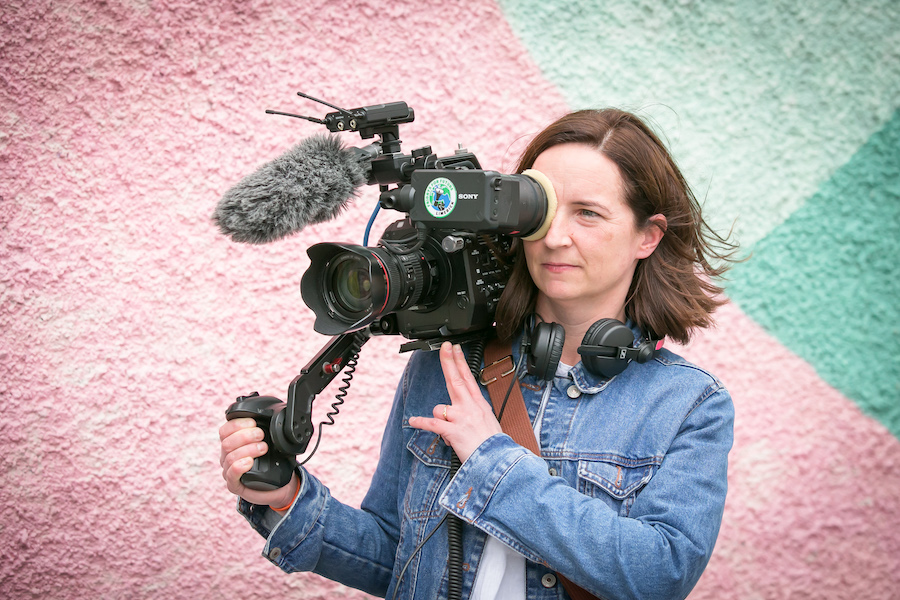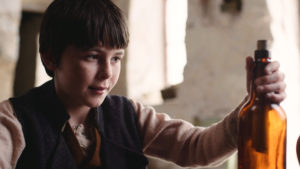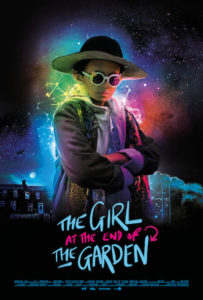
At WFT Ireland, we are constantly inspired and impressed by the caliber of work being done by our members across the film industry. So much so, that we have decided to celebrate their achievements with our monthly slot ‘Member in Focus’. For June, we are delighted to feature the work of Bonnie Dempsey, a director, producer and documentary cameraperson, whose shorts have been taking the festival circuit by storm. We spoke with Bonnie about her background, her process when it comes to filmmaking, and her impressive career to date.
When you were younger, what were the films that made a lasting impression on you and why?
As a kid I loved anything that showed, in detail, the lives of other kids who lived in a world different to my own. When we were young there was a man in Waterford City who ran a VHS delivery service from the back of his car with a pull-out tray of video-cassettes in the boot. The kids’ choice was kind of limited to titles like Watership Down and BMX Bandits and our house, being the last house on his rounds, the choice was further limited to the films that other people didn’t seem to want to rent! But he had a copy of a great film called Escape from the Dark which was always available and I was obsessed with. Released in the States as The Littlest Horse Thieves this was a live-action Disney movie with a surprisingly un-syrupy adventure story set in a turn of the century Yorkshire mining town about three kids who hatch a daring plan to rescue these blind pit ponies from the coal mines. I must have watched it hundreds of times. He had some other crackers too like The Black Stallion and The Emerald Forest that were borderline art-house compared to the usual kids fare of the time!
How did you end up working in film? What was your ‘big’ or ‘little’ break?
I went to Dun Laoghaire Institute of Art Design & Technology (now the National Film School IADT ) During my time there I had a summer job in a facilities house in London. I practically worked for free, cleaning filters, flight cases and endless bnc cables. The upside was I got to help build camera packages for testing, assisting crews and technicians as they prepped for jobs, sending camera tests to the lab etc. and really it demystified the whole equipment side of things for me. Going back to college after this experience meant that I felt way more comfortable with the 16mm kits which were available to us as students in Dun Laoghaire. Up to that point there was a sense, for me anyway, that the girls were seen as the producers, editors and writers while the camera roles were often the preserve of the guys. There seemed to be a lot of bluster and jargon surrounding the whole business of shooting on film. Suddenly I felt like – I know how this stuff works – it’s not scary, these are just tools! I started to fully embraced any opportunity to DP or operate camera in college.
After I finished in Dun Laoghaire I started as a video assist operator and then as a trainee clapper loader and then as a film loader / 2nd AC. I had some really amazing experiences and opportunities as a camera trainee. On King Arthur there were four of us trainees who, as per the instructions of DoP Slawomir Idziak, were kitted out with these cute little Aaton A-Minima 16mm daylight-loading cameras and sent off to shoot various inserts, B-roll and alternative coverage. We had an open channel on the radios to the DoP who would give us our stop and some vague instructions. He’d get our telecine’d rushes back and then critique us. It was literally an amazing experience. We were all aware that this was Krzystof Kieslowski’s cameraman, the guy who shot Three Colours: Blue and under his direction we were getting to do things which were completely unheard of for camera trainees. No doubt this was infuriating for the rest of the camera department who were trudging through a really difficult job, with dozens of cameras to service having essentially lost their four trainees to the whim of their HoD. I’m pretty certain that not a single frame of anything I shot made it into the film but it was an incredibly valuable and empowering opportunity. A short while after that I got my own gear with the help of a grant from Waterford City Enterprise Board and started shooting my own projects. This led to television jobs first as a shooting director and then as a series director on all sorts of television and documentary projects.
How long were you in the industry before you could give up the day job? What was that process like?
I don’t know if I’ve ever really had what you’d call a day job! I mean everyone in this business ends up from time to time doing certain jobs just to pay the bills but no matter what the job is (within reason) you’re always in a privileged position if you’re paying your bills doing something you enjoy.
What did you learn from working on the set of big-budget features? Is there anything there you brought to your own work? How does it differ to smaller sets?
I think there are just more people to communicate with on a bigger set and probably a slower communication process than I’m used to in tv. I find now that I’ve dipped my toe back into the drama realm, a few shorts down, my time in television and documentary has almost helped me more in terms of storytelling craft than my time as an assistant on bigger features.
When it comes to working on reality TV, how do you, as a director, construct a story?
I’m not sure if anything I’ve directed is strictly ‘reality tv’. I know this sounds obvious but everyone always wants something. Whether it’s a character in a drama or a real-life participant in a tv programme or documentary. Finding out what they want and why they want it and rather than just following what they do, always makes any story more interesting. Rather than over producing a story, the job is to frame real events or ‘actuality’ in the context of what the character is after or what their agenda is. These are the things that help inform decisions around shooting style, mood and approach of any type of ob doc.
Often with unscripted tv, you’re anticipating several potential outcomes or moments of jeopardy which may unfold down the line. And you spend a lot of time banking things that may or may not pay off but which may be crucial to have if a story goes one way or another. There are a lot of loose storylines or sub-plots that may come to nothing but still need to be kept alive in case they become relevant later on.
Format tv is a different story. While there’s still room for some directorial creativity within a heavily formatted programme, your job is more like going on a shopping trip for the right ingredients while the producer and the editor cook up the recipe in the kitchen.
The Girl at the End of the Garden – trailer from Dyehouse Films on Vimeo.
Have you noticed any changes in this field of filmmaking in the past few years?
Everything is smaller, lighter and cheaper. Expensive and cumbersome gear is not the huge barrier it once was. Emerging filmmakers and storytellers can shoot a great story on entry level equipment, they can find an audience and cut their teeth without sinking everything into a roll of film, neg processing and couriers.
The demographic of crews seems to be changing too which seems to be really healthy with lots more women in lighting, camera and HoD roles, though still nowhere near enough.
You’ve also worked directing for kids TV. What would be the main differences you find with curating stories for younger viewers?
For the most part, the very same storytelling rules apply. Young audiences are often much more media literate than we give them credit for and have a much keener spoof detector. It can be terrifying to sit through a screening of something you’ve made for kids because they are really the hardest audience. These days youngsters are more savvy when it comes to story and plot and have so many more content choices available to them so if you make something that gets a good reaction it can be really gratifying.
On the other hand, very young (pre-school) audiences are not so concerned with overly intricate or complicated plot. For young pre-school audiences, the idea is to offer constant prompts and hints and make things digestible. The thinking is that kids this age respond more to character than plot though I’m still not sure I agree with this theory. In any case, it’s not good enough to say ‘oh it will all make sense in the end’ or ‘keep watching and you’ll find out why’ because a big reveal at the end of a story is too late when the beginning seems so far away.
Can you tell me about starting up Dyehouse Films?
Myself and David O’Sullivan started up Dyehouse Films in 2005 as a way to make the kind of programmes and films we really enjoyed working on. We were then, and still are, operating as freelancers for hire in many capacities whether it be shooting, directing or editing but there was a point where we found we weren’t always thrilled about the kind of gigs we had to do to pay the bills. We started Dyehouse as a way to facilitate the fun projects we wanted to work on.
One of our first films, in collaboration with Waterford Youth Arts, was an imagining of an untold Raymond Chandler story set in Waterford called Nun More Deadly which went on to win at both Cork and Galway film festivals was made with a relatively small budget of €1500. Dave later directed the award-winning Moore Street Masala which was a five-minute Bollywood spectacular funded by the Irish Film Board as one of their Short Shorts. Both of these films were celebrations of the kinds of movies we loved.
We’ve had enormously positive feedback for All in Good Time, a tale of two pen pals and their magic time travelling bottle while The Girl at the End of the Garden is about to start its own festival run.
Our objectives are to make longer-form children’s stories, a feature and a live action series.
Personally, I would love to be able to take my kids to the cinema and have a choice of seeing something that is age appropriate, relevant with a well- crafted story and not necessarily from the States – for a change! With this in mind, our objective is to make continue making great films for kids, our own included.
The Girl at the End of the Garden is a stunning film! Where did this idea begin?
Thanks a million. It was conceived in response to an RTÉjr callout for ideas for the European Broadcasting Union’s Children’s Drama exchange scheme. This is a series of one-off dramas curated by the EBU whereby various participating children’s broadcasters across Europe each make a stand alone drama with the same broad parameters i.e. duration, target audience, protagonist, minimal dialogue (therefore easy to version into other languages ) age etc. on a common theme and the films are shared amongst all the participating broadcasters.
Myself and the writer Rodney Lee had talked about the kind of tale we wanted to tell. Rodney is a big science fiction aficionado and I had a bee in my bonnet about the shambles that is our ‘direct provision’ system and was really eager to get something out there on the subject. I felt we’d have an audience and an opportunity to spend some of the license fee so why not use it for good – so to speak. We talked about doing a film where, by stealth, we could introduce notions of empathy, understanding and integration to a young audience but we had to do it via a really good yarn, which Rodney is great at.
When it comes to casting for this short, how did you find your two young leads?
With the help of casting agent Nick McGinley, I literally saw kids of every ethnicity and origin for the role of Zed though I was reluctant to cast a youngster who was living through the immediate reality of direct provision hell. My understanding is there’s a lot of stigma felt by some of these children who often don’t want to be outed as living in DP and there’s also a duty of after-care that I just didn’t feel we could provide to a young Direct Provision resident. The other big issue was that to legally engage a child actor, you have to apply to the Department for Justice for a child license and as we know, the right to work is a big issue facing a lot of people in the direct provision system. All this aside I did want to find someone who had some understanding of what a Direct Provision reality might be like. Zed was originally written as a Syrian girl but I was happy to change the characters backstory when we found Thethe Kazadi right under our noses in our local Kevin’s Hurling Club. Thethe had never acted on screen before (though she says she’s been performing from an early age in her bedroom) but she had a great presence and stillness and made a big brave effort to push through any awkwardness that comes with being in front of a camera for the first time. As well as acting, scooting, and eating on camera Thethe had to learn magic tricks (with help from fantastic magician Brian Daly) learn an accent and perform her own stunts, on a wonky scooter for a chase scene.
Ruby Dunne had previously been in the Paddy Breathnach / Roddy Doyle film ‘Rosie’ and when she auditioned for us and she blew us away with her understated authenticity. Ruby is really natural and has genuine funny bones, with great timing and expressions. There can be a lot of pressure felt by young actors in a situation like this where everything is riding on them, these two didn’t let that phase them. They both worked really hard and I know for a fact all the crew are very proud of them.
ALL IN GOOD TIME Official Trailer from Dyehouse Films on Vimeo.
What was the shooting process like?
The shoot was great fun and terrifying in equal measure. The restrictions of child hours are excruciating for all involved. The smallest thing can completely scupper all of your prep. You can find yourself shooting an entire scene in one take despite having spent endless hours working out elaborate coverage and clever shots. The cast and crew were beyond generous with their patience and kindness. I really relied director of photography Tom Comerford a lot. Another Dun Laoghaire alumni, we have a good working relationship and we know each other a really long time and he understands my preferences so I can trust him to not let me make too many bad decisions when things start to get hairy. As well as not letting the bad shots in, he can do a lot with very little – which unfortunately is a recurring theme with our films and the budget restraints we work within.
When can we see it? Any screenings for this, or any other films coming up?
As well as being shown on RTÉ and on children’s broadcasters all across Europe, we’re hopeful The Girl at the End of the Garden will have a good festival run here in Ireland in particular because we desperately want this film to be useful. If it can be helpful as a learning resource, to start a discussion or to aid any conversation about empathy and kindness then we’d feel we’ve done our jobs. Our last short film All in Good Time is still enjoying an amazing international festival run, for which we are extremely grateful. Its next outing is in competition at the Palm Springs Short Fest later this month and it recently scooped the audience award at Newport Beach. With The Girl at the End of the Garden we really hope it can resonate and have impact closer to home. We hope it’s not just seen as a kids’ film and while we’re a bit disappointed it didn’t make the official selection list for the Galway Film Fleadh we are delighted that it will be screened as part of the Spotlight on Migration event happening in the Black Gate in Galway on Sunday 23rd June which is a fundraising night of film and music for a really good cause.
We have another really exciting project in pre-production. Tina Times Two is a dance film for kids which we hope to filming a couple of months’ time. It’s a surreal and funny coming of age fable about a lonely girl from a sleepy midlands town whose wish comes true when she gains a magical friend: an exact double of herself. Her dream turns into a nightmare when her double wants to live her own life. This film is also written by Rodney Lee and is commissioned by RTÉ as this years’ Irish episode of the EBU Children’s Drama scheme. We’re thrilled to be collaborating with some great people like composer Sarah Lynch and choreographer Jessica Kennedy from Junk Ensemble. We’re still casting and at the moment as this is a tricky and challenging role for whoever will eventually play Tina (and her doppelganger Tina 2)
When it comes to telling stories, what are the key themes that you look for in a potential project?
As our kids are growing, the kinds of films we’re interested in making are changing! Themes of friendship, bravery and social justice are what are important to us at the moment but any story we’d consider as a potential project has to be exciting, funny and empowering for young people but above all a really good yarn with plenty of surprises!
About Bonnie Dempsey
Bonnie Dempsey is a director, producer and documentary cameraperson. A graduate of National Film School I.A.D.T. she is one half of Dyehouse Films who specialise in making films and television programmes for children and young people. Dyehouse have made four award winning short films and their latest film The Girl at the End of the Garden, written by Rodney Lee, is being very well received.
JOURNEYCAM PROMO from Dyehouse Films on Vimeo.






